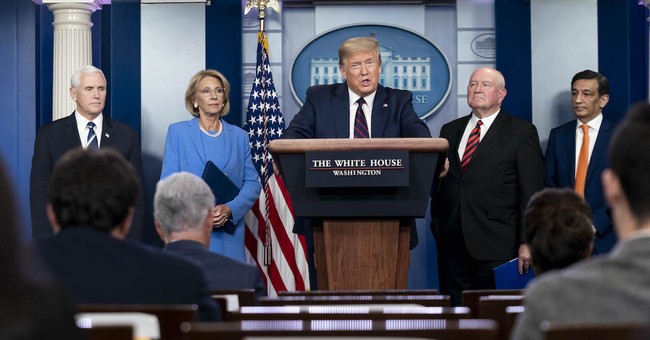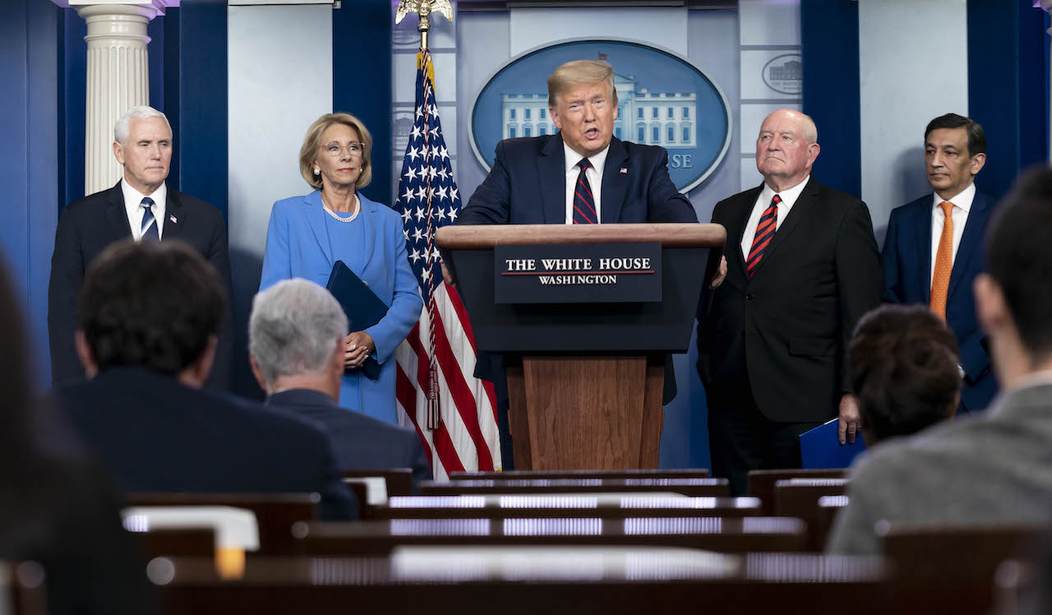
President Donald J. Trump and Vice President Mike Pence, joined by Secretary of Education Betsy Devos, left, and Secretary of Agriculture Sonny Perdue and members of the White House Coronavirus Task Force, delivers his remarks at a coronavirus (COVID-19) update briefing Friday, March 27, 2020, in the James S. Brady Press Briefing Room of the White House. (Official White House Photo by Andrea Hanks)
While there has been the bad news of Boris Johnson being moved into the intensive care unit in London, there’s actually been some good news on the virus fighting front today.
The University of Washington’s Institute for Health Metrics and Evaluation (IHME) model, one of the models frequently referred to by the White House in talking about virus predictions, has just been updated to reflect sharp declines in the estimates of cases, deaths, hospitalizations, and bed shortages.
Townhall notes how different their predictions were from reality:
On April 4th, for example, the IHME model predicted there would be between 120,963 and 203,436 Americans requiring hospitalization, with the average of that range being 164,745. In reality, there were 18,998. […]
That’s just hospitalizations, when it comes to intensive care beds, the difference between the projections and reality show an equally large gap. The average projected ICU beds needed on April 4th was 31,057; the reality was 4,686. That’s across the country, not just New York. Even after factoring in the caveats about missing states, that’s a miss akin to swinging and striking out on a pickoff to second base.
The @IHME_UW model vs reality for New York State, April 5. The model is less accurate than ever. 69K beds projected, 16.5K actually needed; 12,346 ICU beds projected, 4376 needed. Even better (tho not for the model), overall bed count rose less than 600 statewide – less than 4%. pic.twitter.com/TfjtOQNUtq
— Alex Berenson (@AlexBerenson) April 5, 2020
Now, they are revising those predictions based on the actual information they have in from New York and other places in the U.S., and not just relying on European results.
“Updated COVID-19 estimates find that need for hospital beds, ICU beds, and ventilators needed to deal with the COVID-19 epidemic are less than previously estimated,” the AP reports, adding that IHME used data from European outbreaks to better understand how patients are selected for intensive care units and how long most coronavirus-related ICU stays last.
“As we obtain more data and more precise data, the forecasts we at IHME created have become more accurate,” the IHME’s president told the outlet “And these projections are vital to health planners, policymakers, and anyone else associated with caring for those affected by and infected with the coronavirus.”
While they are still forecasting 81,766 deaths in a range between 49,431 and 136,401 with a peak day of April 16, that’s far less than prior estimates.
Overall US:
-# of deaths projected decreased from 93,531 to 81,766
-Projected total bed shortage went from 87,674 to 36,654
-Peak dates(April 15 for resource needed peak, 16th for peak daily death toll) unchanged
-Under 200 deaths a day: Moved from June 3 to May 18— Alicia Smith (@Alicia_Smith19) April 6, 2020
University of Washington just updated their model. Now shows the coronavirus outbreak over much sooner. Projected total deaths down to 80k. https://t.co/waw7xZnx6P
— Clay Travis (@ClayTravis) April 6, 2020
Who wants to bet that those revised projections are overestimates, as well?
As Sean Davis of The Federalist pointed out, their “updated” model is obviously still off, as it shows 4037 projected in Florida by the end of the day when there are in fact 1572 today in reality, so that number is not going to be made.
On April 2, IMHE predicted that 4,158 people in Florida would be hospitalized right now due to the coronavirus. The actual number of hospitalizations in Florida? 1,572. The “new” IMHE model claims 4,037 Floridians will be hospitalized by th end of the day. Utter nonsense. pic.twitter.com/ZgjOEgSBp0
— Sean Davis (@seanmdav) April 6, 2020
These projections are supposedly based off of staying under lockdowns until the end of May. By then, the economy will be in shambles. So, the question is how can they address the issues without driving the economy under with models that are ever-changing and upon which major policy decisions that affect all Americans are being made.












Join the conversation as a VIP Member